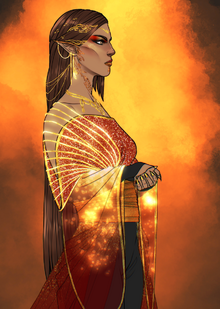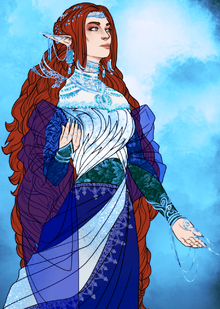More actions
| Lanlath | |
|---|---|
 | |
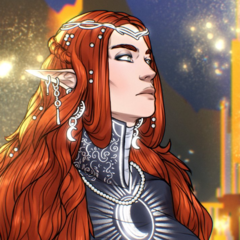 | |
| Nation State | Lathan Empire |
| Ruler | Varied Princes and Princesses |
| Other Present | None |
| Languages | Altalar |
| Religion | Estelley |
| First Recorded | 15,000 BC |
| Demonym(s) | Lanlath |
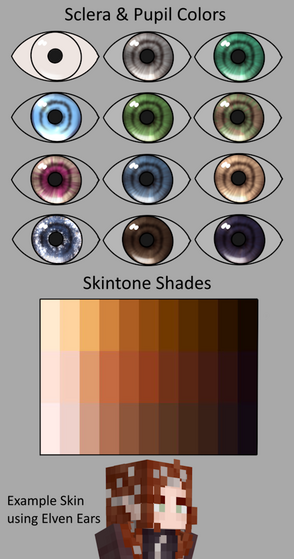
The Lanlath are the classical High Elves of Aloria, skilled in Magics, clever and thoughtful with their words, and with poise and grace that is difficult to rival by the other Races of the world. The Lanlath are the Elves of the hidden valleys, a nation without boundaries that was once expelled from the ancient Allorn Empire for resisting conformity with the ever-expanding and brutalizing Elven dominion. Under the guidance of their secular and religious leaders, the Lanlath departed from the Allorn Empire, creating a realm of their own where the sentiments of justice, compassion and grace would temper the chaos and powerful allure of Magic. The Lanlath are best known across the world for their secretive Empire in the in-between lands, and their contributions to the creation of Radiant Magic, inventing for the first time in Alorian history the means to use Magic without damaging the world and the people in it. The Lanlath have two unique pupil colors (seen right), the Lanlath Midnight and Lanlath Sunrise. The Midnight variant is a dark-gray blue with glowing white specks that imitate the night sky, while Sunrise is ivory colored on the outside, and magenta colored on the inside with inner-heterochromia (two colors in each pupil).
Design
The Lanlath are Aloria's interpretation of the High Elf who is above it all, too detached from the world to care about the chaos in it, too enlightened to engage in the banal discussions that invoke family drama and romance conflict. The Lanlath come in two flavors: resting-bitch-face, and sees-right-through-you-face, where even if a Lanlath is kind-natured and has good intentions to others, much of that goodwill is undercut by how bored or "done" they look with the world. The Lanlath always invoke a floating and drifting mind, expressed with elegant and fluid poise and class, and an abhorrence of chaos, unruliness, and wildness. Lanlath don't all need to be thin spindly or frail-looking, just like the other Elves Lanlath are surely capable of packing on muscle and weight, though due to their high rates of vegetarianism and sometimes just forgetting to eat while musing their theories or playing the harp, these are more the exception than the norm. The Lanlath have a wide variety of visual traits, as seen in the sheet to the right. Most Lanlath veer on the tall side and frequently keep their hair long and well-maintained. Finally, Lanlath expressions of emotion and passion are extremely muted, or well hidden away from the public. Many Lanlath would consider holding hands very risqué, and think a hug is some form of intimate contact.
Lanlath in Regalia
Lanlath are certainly some the least numerous Elves in Regalia (bar for perhaps the Sihndar), due to the habit of the Lanlath to remain in Lathan, their homeland and Empire in the in-between lands. There is however a healthy exchange of people going between Lanath and Regalia, for a variety of reasons, that can all be used to explain why a Lanlath Character might be in Regalia:
- Lanlath are naturally akin to therapists, diplomats, or problem solvers, who use their own ascended philosophies, to help guide others to peace and healing.
- Lanlath despite being detached from the world of Aloria, are sometimes still concerned about the Chaos in it, and will help the other People of Aloria keep it safe.
- Lanlath are natural musicians, poets, and lovers of art and beauty. Many of them travel to Regalia to learn from other musicians, or to share their art with the world.
- Some Lanlath are Knights, being members of the Senleya Order and helping the Regalian Empire preserve peace and stability and giving final mercy to Spirits.
- The Lanlath are often a cornerstone to "proper" Magic teaching by straying from Sinistral, and following their Radiant theories. They often teach Magic in Regalia.
- Lanlath are often speakers for causes for the good of the world that the general public ignores, like the Sihndar struggle, the Dwarven extinction, the Isldar war etc.
Heritage Traits
When designing a Character, Proficiency Points allow for a limited Ability selection with Point Buy Packs. Heritage Traits adds free Packs and Mechanics on top of that to help with cultural themes. Free Packs grant Abilities usually, while Mechanics change the way a character functions in Roleplay through subtle, and usually out of Combat ways. In essence, Mechanics just add aesthetic flair that invest in the niche of each culture. Free Packs never raise Proficiency Points, but the character must be able to purchase them normally. (ex. if a character is a certain Affinity that locks them out of a category, they cannot take that specific free pack and must choose the alternative option.) If a Free Pack grants Magic of some type, that Magic can be of any Alignment the character can normally choose, or limited to a select alignment, which will always be written in the Free Pack description. Mixed Heritage characters (i.e. characters born from two parents of different Cultures) may take one parent's 'Free Packs' and mix and match up to 5 Mechanics from both parents, although some Peoples cannot produce Mixed Heritage children (due to Magical/Fantasy reasons).
Free Packs
- Lanlath choose two Packs from Magic Point Buy for free.
Mechanics
- The two Free Magic Packs chosen from Heritage Traits, can be used as the Sinistral Variant, but will always be Radiant instead and cannot be forced Sinistral.
- Lanlath cannot use God Magic. However, Lanlath can Dimension Align to Lathan Magic, which is extradimensional like Void/Exist/Ordial, and unique to the Lanlath.
- Lanlath do not need to sleep, but can do so if they wish, or enter into a trancelike state of meditation that approximates sleep but leaves them watchful.
- Mechanic
- Mechanic
Lathan Essence
Lathan Essence is magical energy from the Lathan dimension, explained further below. Lathan is both a Dimension and a Dimensional Alignment, much like the Void, Exist, or Ordial Dimensions are, but it is distinctly different from them. Unlike these Dimensional Essences, Lathan Essence is completely incapable of corrupting Aloria by itself. Lathan Essence can still be used to generate Sinistral Magic, and it can still cause widespread destruction, but the passive existence of it does not twist and corrupt plant life like for example Ordial or Void Essence would. Lathan Essence is identified as sereneness, light-headedness, foggy-ness, feelings of floating, and feelings of weightlessness. It is generally ascribed good qualities, but this again does not mean it is exclusively good and other forms of transdimensional Essences purely bad. Lathan Essence has in part affected the Lanlath to a degree of detaching them from worry and involvement or a sense of responsibility over Aloria. This is also why some of its critics, call it the "Apathy Magic". Lathan Essence is technically a fifth Dimensional Alignment, but is not present on the Magic Page because it is only accessible to Lanlath.
Starbirth
Lanlath have a cultural tradition that each Lanlath goes through as they come of age, known as the Starbirth. Lanlath distinguish a difference between natural birth and Starbirth, in that the latter occurs during a coming of age ceremony in a Star Chamber, where the ambient magics reveal their personality and inclinations, then forming a Star in the ceiling of the room to indicate between the four Starsigns. The Lanlath acknowledge that some Dimensions are more suitable for certain personalities, while other personalities cause calamity if they come into contact with certain Dimensions. In a way, Starbirth is how the Lanlath find the most appropriate Dimensional Alignment for their people, so that they can best master the arts, and have as little risk as possible to be corrupted or possessed by a Spirit. Starbirth does not prevent a Lanlath from Aligning with multiple Dimensions in the future, but this considered a massive Taboo in Lanlath society, to defy the will of the Star Chamber, and reason enough to become pariah to Lanlath society, those individuals referred to as Starfallen. It is not possible to be Starborn to God Magic, as the Lanlath are unable to use God Magic due to their connection with the Dimension Lathan. Note that the color distinctions of Void Gold-Red, Exist Blue-Silver, Ordial Black-Green, and Lathan Magenta-Ivory are purely aesthetic visuals. Nobody is forced to clothe themselves in colors they do not like, though it is always a fun little alignment indicator for people's styling.
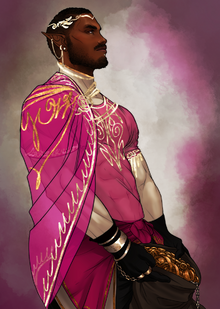
|
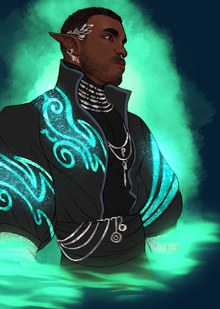
|
Lathan

To fully understand the Lanlath, Lathan must be known both as a cultural concept and what it is. Lathan, much like the Void, Exist, or Ordial, is a distinct Dimension separate from Aloria, however it is not quite the same as these very alien realities. How Lathan was originally found or created is unclear. There are prevailing theories that Lathan was created by the first Lanlath exiles from the Allorn Empire, while others claim that Lathan is the mind of a God, while others yet claim that Lathan was already in existence, but that it was devoid of life, and that the Lanlath cultivated it when the Estelley God Leyon opened the doors. Whatever the origins, Lathan is the Lanlath homeworld away from Aloria. They tried to create a land of their own, but would not conquer or take land from other cultures or people, and so manifested an Empire in the "in-between lands" as it is sometimes called. There are several entry points into Lathan, large gateways on the major continents that are guarded by the Lanlath on both sides, but the majority of them are concentrated in the island chain located to the west of Regalia, on Maartasil, Etosil, and Mirtasil, which was once the easternmost border of the Allorn Empire. Lathan is a magical realm where time does not seem to pass. The sky is permanently cast in a cloudless dark blue haze, while the sun shines a bright golden magenta glow over everything. The valleys are outlined with massive mountains going nowhere, rolling pine forests with no creatures save for the Lathan dove, and rivers without fish irrigating farms from which the Lanlath eat. Their cities are vast citadels of ivorystone, with golden domed roofs that reflect the permanently setting sunlight. Lathan appears as if it is in a permanent autumn sunset, fogs rolling along the periphery of the cities which are often hundreds of miles apart from one another with endless stretching abandoned wilderness in between, with only elemental gateways connecting them and allowing fast travel between them. Lathan is a peaceful realm, where the Gods of Aloria and other Dimensions cannot tread, and where those who have ill will towards the Lanlath are magically rebuked from entering the gateways to this tranquil place. The Lanlath protect Lathan with their lives, and are equally as fanatic in preserving its secrets. Only the most trusted non-Lanlath could ever dream of entering Lathan, to live with a loved one, or study under an Archmage of the Lanlath.
Language and Naming
Brief History
Conflicts & Alliances
Religions
Culture
Families and Romance
The Lanlath are incredibly formal about their sense of romance, with a long poetic culture stretching back thousands of years. Considering it in its own way sacred, they are very slow to fall into and out of it, with courting one becoming so complicated as to often be considered arcane or even impossible by outsiders. It is held that they treat their commitments with an uncommon seriousness, as they believe that what is difficult to create is just as difficult to break, thinking that a commitment made casually can be abandoned just as fast. It goes without saying that they are also a deeply monogamous culture. Acts of affection for the Lanlath are usually drawn-out and high-effort, with the amount of time put in communicating the amount of care laying behind. Gifts like calligraphy and paintings that pander to their sense of artistry are usually effective, with anything handmade by the partner being valued well above something purchased from someone else and gifted. Owing to their long lifespan, Lanlath families are incredibly hierarchical around the ruling patriarch or matriarch, whose word is law. Disobeying the head of one's family is considered immoral even if their requests are unreasonable or misplaced, a fact which has written quite a few dramatic poems over the centuries. The larger Lanlath families and especially the Noble houses like to stake a claim to direct lineage from the original council of Princes who dissented against Allorn rule and led to the movement that would become the Lanlath, keeping long and winding genealogies.
Clothing
Lanlath fashion is dignified and enrobed. While not necessarily always covering, the focus is more on the quality of the fabric and complexity of the jewelry and draped silhouette, rather than the person underneath. Gold, silver, and precious stones are all used in equal measure to complement the color of the cloth they are paired with, without a particular bias in any one direction. Moreover, the Lanlath do not recognize a distinction between male and female clothing, but do have masculine and feminine forms depending on the occupation of the wearer that may favor ease of movement over extravagance or vice versa. Motifs such as flowers, stars, the celestial bodies, Elven calligraphy, and all else commonly associated with the graceful and fair frequently find a place among their personal styling as pendants or embroidery. The four Lanlath figures in the Starbirth section make good examples of their sense of styling. Philosophically speaking, the Lanlath consider that clothing is supposed to communicate the intended presentation of the wearer: unlike stature or facial features, which are commonly not chosen, one's sense of dress is. Not just concerning itself with whether someone looks subjectively 'good' or 'bad,' Lanlath culture tends to over-read into the implications of a particular clothing selection. If someone dresses to attract like the gilded dresses of the Ithanians and flower-skirts of the Yanar, or intimidate like the tight militant vests of the Fin'ullen and the bare muscle of the Eronidas, this is always taken as an intentional choice made for a reason. As can be imagined, pickier Lanlath may enjoy asking just a few too many questions about others' outfits at parties over wine.
Art
Lanlath art has been described as the crossing point between dreamy and vivid, bright colors that nevertheless seem to meld together into a slumbering haze. Most of their cultural works are produced with the brush: calligraphy, poetry, paintings, frescoes, and other paint or ink-reliant mediums as opposed to the statues, etchings, or cast bronze favored by others. The Lanlath school holds that art is intended to permanently capture the emotions of a particular moment for later consumption by others. The character of that moment is irrelevant, whether glorious or tragic, blessed or not, as long as it is something that another could benefit from understand. Many of the Lanlath Archmages are known to have taken this concept one step further, favoring paintings as the anchors for their portals that literally draw one into another realm if understood correctly. Considerable artistry is poured into Lanlath metalwork as well, predominantly the fabled material Nightsilver and all the arms and armor produced thereof, purplish like the midnight sky and shimmering like speckled stars. Equal to the creations of the Eronidas and the Dwarves, Lanlath craft carries a timeless grace that seldom dulls with age or fades with overuse. They make for storied finecrafters and jewelers as well, working shimmering thread and thin chains into complex paired ensembles that tell a story together. As for their poetry, one should not accept an invitation to a Lanlath reading ceremony without expecting to set aside at least eight hours. It is considered a contender with the Isldar style for the finest of Elven production, with the Isldar having a larger output of short poetry and the Lanlath of verbose lays and sagas that span decades of heroics.
Cuisine
The Lanlath are predominantly vegetarian, brought on by the fact that their home realm of Lathan does not contain wildlife save for the Lathan dove, which they do not hunt. Many of them choose to remain vegetarian in Aloria proper, both out of habit and out of a Mana worship-motivated desire not to hurt animals unnecessarily. The Lanlath diet could be further described as sweet, tangy, and floral, with an unusual mixture of fantasy ingredients from different fruits and thick-petaled starchy blossoms that can be ground into meal and baked. Lacking the climate in Lathan to grow anything resembling sugar, they rely on honey or various extracts for sweetener. While usually spiceless, Lanlath cooking is not considered tasteless like the Northern Ailor diet of meat, potatoes, and cabbage, solely due to the creative ways they have devised to use the large range of fruit that grows in their realm. Tea is also considered a Lanlath staple, mostly black tea as opposed to the Sihai green, with different kinds of vanilla root flavors held in tradition: some sweetened, or muddled with bark. Since most Lanlath recipes produce nothing even slightly resembling muscle in those who keep to it, the soldiering and Knightly classes have devised an eclectic combination of gluten-based protein (seitan/mianjin), lentils, oats, and almonds ground into meal to use across a variety of dishes as a means of substitution. A common Lanlath joke goes that the conscription office is an oatmeal cookery that happens to be accidentally staffed by bureaucrats.
Architecture=
Eronidas Architecture is elegant and yet familiar to outsiders. This is largely because while Altalar crowned their achievements in building vast tall structures, the Eronidas invented the necessary load-bearing arches and dome structures used in Ailor cities in the modern era for temples. Many Ailor are not aware of this fact, but most of what the Ailor architects call Gothic architecture was only enabled by the inventions of the Eronidas and their complex weight distribution mathematics. For their own city-states, the Eronidas have adopted the pillar-based structures of Altalar temples and Aetosian buildings, but made it their own and developed it entirely independently from these other Cultures. Their long, temple-like structures are built in a rectangular shape on a raised slab of thick brick, which is called a Solon. There is no real staircase entry or even a slope, and to enter such a building one must climb on top of the slab, which is often six feet off the ground. The rectangle is surrounded by pillars which are often expertly carved in the image of either some wild creature, or an Eronidas holding up the roof. The roof itself is a beam support section without nails or fastening, an ingenious construction of interlocking wooden panels that are both flexible and yet retain their sturdiness. It is said that because of these wooden panels, Eronidas buildings are the only ones completely immune to earthquake and tremor damage, and because of their height, suffer little to no flooding damage either. They do not have any walls, windows or doors, rather, the various rooms are separated by dyed cloth suspended from metal wires spanning between the pillars. Each room has a specific color with a specific purpose. These Solon are used as public gathering places to have fun and meet new people in, or just to relax and consume opiates. While alcohol is strictly forbidden in public, being under the influence of relaxant opiates is not.
Lanlath architecture is considered the pinnacle of elegance without the ostentatiousness of Allorn designs in Daen, eschewing thousands of clumped towers for more attention paid to each one.
Recommended Playstyle
Trivia
- Trivia
- Trivia
- Read the Silmarillion.
| ||||||||||||||||||||||
| Accreditation | |||||||
|---|---|---|---|---|---|---|---|
|
| ||||||
